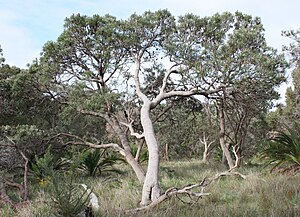Banksia attenuata
| Habit | shrub
| |
|---|---|---|
| Height: | ⇕ | 25 ft"ft" can not be assigned to a declared number type with value 25. to 35 ft"ft" can not be assigned to a declared number type with value 35. |
| Width: | ⇔ | 17 ft"ft" can not be assigned to a declared number type with value 17. |
| Lifespan: | ⌛ | perennial |
| Origin: | ✈ | SW Australia |
| Exposure: | ☼ | sun |
|---|---|---|
| Water: | ◍ | moderate, dry |
| Features: | ✓ | flowers |
| USDA Zones: | 9 to 10.5 | |
| Flower features: | ❀ | yellow |
|
Banksia > |
Banksia attenuata, commonly known as the candlestick banksia or slender banksia, is a species of plant in the proteaceae family. Commonly a tree, it reaches 10 m (35 ft) high, but is often a shrub in dryer areas 0.4 to 2 m (1–7 ft) high. It has long narrow serrated leaves and bright yellow inflorescences, or flower spikes, held above the foliage, which appear in spring and summer. The flower spikes age to grey and swell with the development of the woody follicles. It is found across much of the southwest of Western Australia, from north of Kalbarri National Park down to Cape Leeuwin and across to Fitzgerald River National Park.
The candlestick banksia is pollinated by and provides food for a wide array of vertebrate and invertebrate animals in summer months. Several species of honeyeater visit the flower spikes, as does the honey possum, which has an important role as a pollinator. It regenerates from bushfire by regrowing from its woody base known as a lignotuber, or from epicormic buds within its trunk. Plants may have a lifespan of 300 years. It has been widely used as a street tree and for amenities planting in urban Western Australia, though its large size generally precludes use in small gardens. A dwarf form is commercially available in nurseries.

Banksia attenuata is generally encountered as a tree up to 10 m (35 ft) tall. In the north of its range as the climate becomes warmer and dryer, it is often a stunted multistemmed shrub 0.4 to 2 m (1–7 ft) tall. Both forms occur in the vicinity of Hill River but there is otherwise a marked demarcation.[1] In the Wheatbelt and east of the Stirling Range, it is a stunted tree. Tree forms have a solid trunk, generally wavy or bent, with 1–2 cm (0.4–0.8 in) thick crumbly orange-grey bark which is a red-brown underneath.[2] It regenerates from fire via lignotuber or epicormic buds from its fire-tolerant trunk. It has long narrow shiny green linear leaves 4 to 27 cm (1.6–11 in) long and 0.5 to 1.6 cm (0.2–0.7 in) wide.[3][4] The leaf margins have v- or u-shaped serrations along their length. The new growth is a pale grey-green, and occurs mainly in the late spring and summer,[5] often after flowering. The brilliant yellow inflorescences (flower spikes) occur from spring into summer and are up 5 cm (2 in) wide and up to 25–30 cm (10–12 in) tall.[2] They are made up of many small individual flowers; a study at Mount Adams 330 km (200 mi) north of Perth revealed a count of 1933 (± a standard error of 88) flowers per inflorescence,[6] and another in the Fitzgerald River National Park yielded a count of 1720 (± 76) flowers. Anthesis proceeds up the flower spike over about 10 to 20 days, and is asynchronous. That is, a plant produces flower spikes over a several week period and will thus have spikes at different stages of development over the flowering season.[7] Often bright green in bud stage,[8] they are terminal, occurring at the ends of one- to three-year old branches, and displayed prominently above the foliage.[2] The smell of the open flowers has been likened to a peppery Shiraz wine.[8] Over time, the spikes fade to brown and then grey,[3] and the individual flowers shrivel and lie against the spikes. This coincides with the development of dark furry oval follicles, which measure 2–3.5 cm (0.8–1.4 in) long, 1–1.5 cm (0.4–0.6 in) high, and 1.4–2 cm (0.5–0.8 in) wide.[2] However, only a very small percentage (0.1%) of flowers develop into follicles; the field study at Mount Adams yielded a count of 3.6 ± 1.2 per cone.[6] The follicles develop and mature over seven to eight months, from February to December, while seed development occurs over four months from September to December.[9]
Cultivation
Propagation
Pests and diseases
Varieties
Gallery
References
- ↑ Cowling, Richard M.; Lamont, Byron B. (1985). "Variation in serotiny of three Banksia species along a climatic gradient". Australian Journal of Ecology 10 (3): 345–50. doi:10.1111/j.1442-9993.1985.tb00895.x.
- ↑ 2.0 2.1 2.2 2.3 Template:The genus Banksia L.f. (Proteaceae)
- ↑ 3.0 3.1 Cite error: Invalid
<ref>tag; no text was provided for refs namedGeorge96 - ↑ Template:Cite encyclopedia
- ↑ Template:The Banksia Atlas, pp. 54–55
- ↑ 6.0 6.1 Cowling, Richard M.; Lamont, Byron B. (1987). "Seed bank dynamics in four co-occurring Banksia species". Journal of Ecology 75 (2): 289–302. doi:10.2307/2260419. Template:Subscription
- ↑ Wooller, Sue J.; Wooller, Ronald D (2001). "Seed set in two sympatric banksias, Banksia attenuata and B. baxteri". Australian Journal of Botany 49 (5): 597–602. doi:10.1071/BT00084.
- ↑ 8.0 8.1 Collins, Kevin; Collins, Kathy; George, Alex S. (2008). Banksias. Melbourne, Victoria: Bloomings Books. pp. 68, 150–51. ISBN 1-876473-68-1.
- ↑ Stock, W.D.; Pate, J.S.; Rasins, E. (1991). "Seed developmental patterns in Banksia attenuata R.Br. and B. laricina C. Gardner in relation to mechanical defence costs". New Phytologist 117 (1): 109–14. doi:10.1111/j.1469-8137.1991.tb00950.x.
External links
- w:Banksia attenuata. Some of the material on this page may be from Wikipedia, under the Creative Commons license.
- Banksia attenuata QR Code (Size 50, 100, 200, 500)
